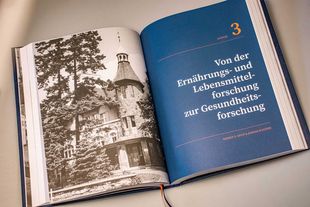The result is a historical treatise that offers the reader an informative overview of the evolution of the research site in five chapters. The recently published 353-page book* is titled “Von der Verpflegungswissenschaft zur Gesundheitsforschung – Ernährungsforschung in Potsdam-Rehbrücke (1946 2021)”. (English: From Food Science to Health Research – Nutrition Research in Postdam-Rehbruecke (1946 2021)”.
The Birth of the Book Project
The original idea for the book emerged in 2017 and was the brainchild of Prof. Tilman Grune, Scientific Director at DIfE. “I had in mind a historical account of nutrition research in Rehbruecke and the people involved, for example, Arthur Scheunert,” explains Grune. “I wanted to create a foundation upon which the DIfE could position itself regarding historical events”.
The science historian PD Dr. Georgy Levit from the University of Jena was commissioned by the Institute’s board of directors in 2017 to begin the necessary research and compile the treatise. He was supported by long-serving DIfE employee Dr. Judith Schäfer, who is credited as a co-author.
Detective Work in the Archives
To paint the most comprehensive picture possible of the history of nutrition research in Rehbruecke, Levit and Schäfer consulted various archives across Germany. They studied numerous documents and viewed estate papers and images. Furthermore, the relatives of former Institute scientists granted the authors insights into their family archives and provided them with photos and informative background information. They then rounded-off their research by interviewing current and former DIfE staff members.
The research of the Central Institute for Nutrition (ZfE) was particularly challenging. “Because the DIfE is not the official legal successor of the ZfE, after the fall of the Berlin Wall, all historical documents and photos were packed into around 460 boxes and sent to the Main State Archive of Brandenburg (BLHA),” reports Schäfer. Since then, the boxes have been unpacked and approximately 2000 files made available. Despite pandemic-related restrictions, Schäfer and Levit were able to obtain a great deal of important information from the files during weeks of meticulous research work at the BLHA. “I find it impressive that scientists in the former East Germany were able to produce internationally recognized findings despite the societal restrictions and adverse circumstances,” says Schäfer.
The authors obtained additional information pertaining to the ZfE during their research at the archives of the Berlin-Brandenburg Academy of Sciences and Humanities and the Stasi Records Agency. “It is incredible that, despite all the social upheaval, continuity and tradition in the field of nutrition research was sustained over decades,” says Levit. The relationship between nutrition and health was always a central topic for the scientists.
Three-Quarters of A Century in Four Chapters
The first chapter describes the work of Arthur Scheunert and Wilhelm Ziegelmayer, the beginnings of vitamin research and its transition into nutrition research. “The foresight displayed by the Institute’s founders at that time is astounding,” says Schäfer. In the second chapter, Levit and Schäfer look at the institutionalization of nutrition research in Germany. Here, the focus is on the establishment and development of the ZfE in the former East Germany, illustrated, among other things, using the example of Manasan baby formula. The chronology at the end of the chapter provides an overview of nutrition research in Potsdam-Rehbruecke. It details the names of the institutes and their directors, as well as the topics and fields of research from 1946 until the end of 1991. In the third chapter, the book continues with the period of German reunification and the transition from ZfE to DIfE. This chapter also ends with a chronology presenting the most important political and institute-related events from 1989 to 1992.
The fourth chapter deals with the establishment and evolution of the DIfE and its research from 1992 until 2021. The first subchapter is dedicated to the founding director, Prof. Dr. Christian Barth. “The founding of the DIfE was an important milestone in the development of nutrition research in Germany,” summarizes Levit. The DIfE chapter contains three interviews with the former Scientific Director, Prof. Dr. Dr. Hans-Georg Joost, and the current Scientific and Administrative Directors, Prof. Dr. Tilman Grune and Dr. Birgit Schröder-Smeibidl. The end of the chapter provides a chronology of the main research topics and departments at the DIfE from 1992 to 2022.
Looking to the Future
In the fifth and final chapter, Prof. Dr. Tilman Grune provides an outlook on the scientific development of the DIfE and the challenges it will face in the future. “The study of the effects of sustainably produced food on the metabolism will become increasingly important,” explains Grune. Levit adds “This brings us full circle, because research into food and the development of new sources of nutrition, which was the most pressing task during the post-war period, is once again an issue in view of the current global challenges”.
The DIfE board and the authors would like to take this opportunity to thank all those who supported this book project, especially the Main State Archive of Brandenburg (BLHA).
Background Information
*This book looks at the evolution of the DIfE and its predecessor institutes, but not the Institute of Nutritional Science at the University of Potsdam (IEW), which is located on the same campus.
The book was compiled in collaboration with the Synchronschwimmer design agency in Frankfurt and 1000 editions were printed.
Those interested should contact the DIfE public relations department.
Contact
Public Relations
Phone: +49 33200 88-2335
E-Mail: presse@dife.de

